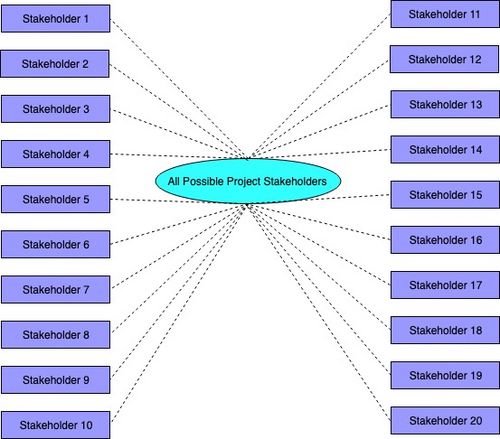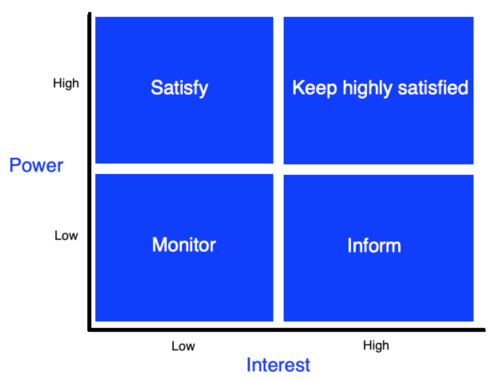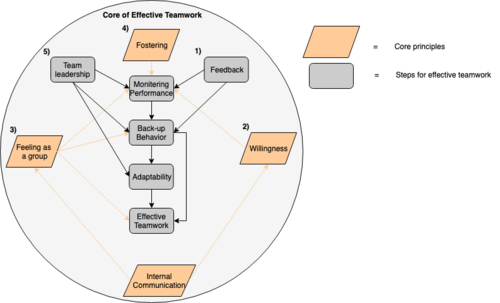Stakeholder Management Processes in Projects
Abstract
A Stakeholder Manager is an essential element for a prosperous project, program or portfolio. A stakeholder is an individual who will or can be affected by the aforementioned aspects. Thus, stakeholder management considers how the relationship between stakeholders can be affected and what processes can mitigate altercations. Stakeholder management processes are fundamental through businesses, organisations and projects, a set of strategies were developed to analyse stakeholders. The goals for the stakeholder management processes are to:
- Maximise supportive stakeholder engagement in projects
- Ensure the processes are understood by all stakeholders
- Introduce multiple key principles and processes for different stakeholder situations
This article looks into how essential separate stakeholder processes are for projects. Powerful stakeholders can be used in early development of projects or portfolios to improve quality. “The ability of the project manager to correctly identify and manage these stakeholders in an appropriate manner can mean the difference between success and failure”.[1] But, this can only begin once resources and a general understanding of the problem is gained through multiple meetings. Thus anticipation and prediction allows the Stakeholder Manager to plan and support their actions. This article focusses on the effective teamwork via Stakeholder Management Processes. Nevertheless, all topics regarding Stakeholder Management are mentioned for a clear understanding of the entire process. This can only start through Stakeholder Identification processes.
Contents |
Stakeholder Identification
Before the management can begin with multiple processes within a project, an identification is essential. The identification includes an initial brainstorm investigating all stakeholders who are potentially affected by any decision throughout the project. Stakeholders can be businesses, companies, individuals or educational industries; therefore, spending a sufficient amount of time on the identification process is fundamental. The following questions should be asked during the brainstorming session to embark on the identification process:
- Who is the suppler of the project?
- Who is the customer?
- Who influences the main stakeholders?
- Who can be affected by the project?
- Who is working towards solving the project?
- Who has the decisions over resources?
- Who is ultimately in charge of the success of the project?
Once these questions have been answered, the stakeholders can be classified and analysed.
The image shows how multiple stakeholders are sprung from a simple beginning. The identification process is the basis for any Stakeholder Manager in the beginning of a project, program or portfolio. Therefore, this process should be conducted with known stakeholders before an analysis process can begin. Thereafter, the analysis of individual stakeholders can commence.
Stakeholder Analysis
Once the identification process is clear and all stakeholders are found and named, the stakeholder analysis can begin. The analysis looks at an in depth classification of individuals in order to find the most relevant for certain situations. This is conducted to aid the Stakeholder Manager within the project in scenarios such as:
- Disruptions of the project due to a stakeholder
- Key stakeholders to inform about critical decisions
- Communication method
- Reducing negative impacts of certain stakeholders
- Timeline for completion of events
- Resources needed from stakeholders
Managing these and engaging key stakeholders is a tool that creates a successful project. The stakeholders can be analysed using a variety of processes. Three of which are shown here.
Power/Interested Grid
One method is the Power/Interested Grid. By classifying each stakeholder by power over work or interest over work.
- High power, interested people: Stakeholders who hold the most power over a project and you must make the largest effort to satisfy. These Stakeholders are extremely important as they are engaged within the project but also have the influence to close down or input with more resources. Hence, keep these stakeholders as satisfied as possible.
- High power, less interested people: Stakeholders who hold the most power but are not that engaged within the project. Equally as important as the prior stakeholder in regards to power but these are not highly interested within the project at hand. You should keep these satisfied but weekly meetings and messages are more relaxed.
- Low power, interested people: Stakeholders who do not have the power over the project but are highly keen on the outcome or issues that may arise. The Stakeholders who are interested but low in power may aid the project in multiple ways as they will be involved. Important to note that these stakeholders are often from outside businesses and although resources might be limited to begin with, investments are frequent as projects come to completion.
- Low power, less interested people: Stakeholders with little power and are no interested with the project at hand. These Stakeholders are the least important but they should still be monitored and analysed for future reference incase they move into a different position.
Stakeholder Interest and Impact Table
A second process for stakeholder analysis is to use a Stakeholder Interest and Impact Table. The table takes all the stakeholder identified in step one, lists them on the left hand-side of the table then remarks all interests of said stakeholder. Once all interests are listed, a project impact rated from low-high is given. The impact noted gives an integer priority number from 1 - n, with 1 being the most influential stakeholder. From the analysis section, stakeholders need to stay engaged. The following section explains how to engage all stakeholders and how influential the commitment of stakeholders outlines a project.
Salience Model
Stakeholder Engagement
Why you should engage stakeholders and how you can keep them engaged throughout the project....
Stakeholder Management Key Principle Processes
The key principles for Stakeholder Managers to keep in mind throughout a project. Whilst making all decisions, this should be the first port of call before taking the risk. There are seven processes that aid a Stakeholder Manager within a project scenario.
1. Early consultation and multiple meetings - A project during early stages is difficult to define to all stakeholders. A meeting regarding all high power and high interested stakeholders (REFERENCE BACK TO PREVIOUS PAGE) should be initiated within the first few weeks of defining the project. The meetings should include a timeline, preliminary budget and main stakeholders with their requirements. This enables a negotiation and initial communication.
2. Communication - Mentioned multiple times within this article, communicate, communicate, communicate. Before trying to influence and relying on stakeholders, gathering, sharing and communicating information is important. A communication platform should be established and focused on within the initiation of the project.
3. Responsibility - As a Stakeholder Manager, it is your role to engage all relevant stakeholders and for you to govern the success. A good Stakeholder Manager takes responsibility for all stakeholders regardless of their status.
4. Success Criteria - A successful project can be defined in infinite ways if different perspectives are asked. Whilst developing the project outline, define what success is meant to the Stakeholder Manager and establish a baseline of success. Once the project is finished, this should be reviewed.
5. Compromise - During initiation, stakeholders often have diverging opinions. A compromise is often swiftly met but if this is not the case then the responsibility lays on the Stakeholder Manager. A weighted hierarchy via a voting system is common but the argument must fulfil the requirements of all stakeholders first.
6. Managing Risk - Starting any project is a risk of some kind. Whether this includes a resource, monetary or time risk. But every risk is an opportunity is correctly endeavored and used, accolades are rewarded. A Stakeholder Manager should at every step of this process, look into what is the largest risk and how can this be mitigated.
7. Plan it, plan it, plan it - There is never too much planning involved for a Stakeholder Manager. For each step, take a measured and conscientious approach to plan. Spend more of your time planning and discussing then you can bring significant benefits to the highest and most interest stakeholders.
Stakeholder Effective Teamwork
As a Stakeholder Manager, working efficiently and effectively on projects is fundamental. The manager is responsible not only for the outcome but for satisfying all relevant parties affected by the process and fallout. According to McIntyre & Salas [2], there are 5 principles of effective teamwork.
1. FEEDBACK to and from one another
2. WILLINGNESS to and from fellow stakeholders
3. FEELING AS A GROUP whose success depends on interaction
4. FOSTERING within-team interdependence
5. TEAM LEADERSHIP affects performance of the team.
The principles aforementioned according to McIntyre & Salas ensure a successful project being ran by a Stakeholder Manager. The feedback establishes a flat organisational structure in regards to communication. This asset declares everyones voice to be heard. The willingness to and from stakeholders
Managing the effective teamwork runs through the heart of all processes in projects. Making sure that the individuals within the project work together cooperatively has three known benefits:
1) Quick and easy problem solving: The first benefit is overcoming plausible problems quick and easily. Once communication, coordination and bonding is established, ideas are constructed and effortlessly announced. Accordingly, solutions are found for problems briskly.
2) Strong staff relationships: Another benefit with effective teammate is a strong relationship between all staff members. A Stakeholder Manager aims at bringing all stakeholders together from juxtaposing areas of the business. Their experiences, knowledge and skills from previous projects can be shared to gain an advantage over competition.
3) Healthy competition: Competition is crucial. Ensuring an indispensable amount of knowledge is gained but it must not detriment a stakeholders reputation. For this, healthy competition is used. Within an organisation, the project or company vision should come first. This means that there should be a constant state of improvement via meetings, self-awareness and motivation incentives. Remember that healthy competition drives a successful project but unhealthy competition breaks a project down.
Annotated Bibliography
[1] The Project Management Institute (PMI) book looks into how identification and planning for the management of stakeholders aids a project. This is the book covering all standards for project management so topics such as project risk management, project human resource management and control management. Many helpful examples and illustrations.


